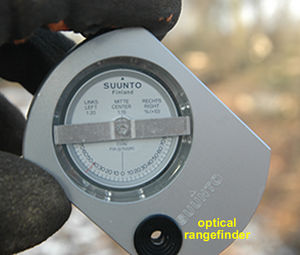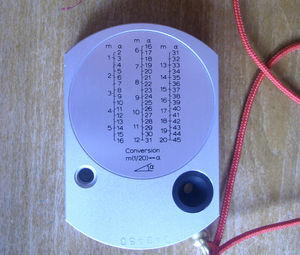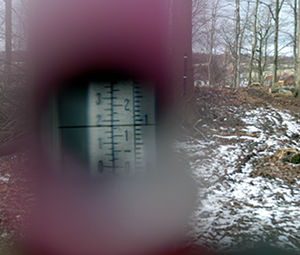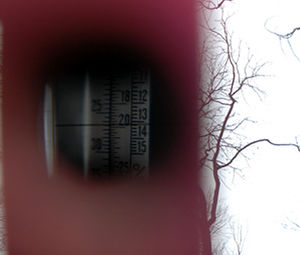Suunto
(→Handling) |
|||
| (13 intermediate revisions by one user not shown) | |||
| Line 1: | Line 1: | ||
| − | + | {{Ficontent}} {{video|link=https://youtu.be/EahhlAazK1Y}} | |
| − | {{ | + | |
==General description== | ==General description== | ||
| − | + | The Suunto ([figure 1]) is a device that is used to measure [[Measuring slope|slope]] and [[tree height]]s within fixed distances (15m, 20m) to the tree using [[the trigonometric principle]]. Therefore the inclination angles to the tree top and bottom are measured from fixed distances. Tree height can then be read from the scales for the respective distance. Some Suunto devices have an optical rangefinder to measure these fixed distances (15m, 20m) optically and a sighting viewer to look on the height scales. The scales implemented are the same as the scales of Silva [[Clinomaster]], but there is additionally a scale for slope measurements in %. | |
| − | The Suunto ([figure 1]) is a device that is used to measure slope and tree | + | |
<gallery widths=300px heights=300px> | <gallery widths=300px heights=300px> | ||
| Line 11: | Line 9: | ||
==Handling== | ==Handling== | ||
| − | # Select desired distance (15m, 20m) to the tree | + | # Select desired distance (15m, 20m) to the tree, |
| − | # Sight the tree bottom with both eyes open (figure 2) and remember the value | + | # Sight the tree bottom with both eyes open (figure 2) and remember the value, |
| − | # Sight the tree crown (figure 3) and remember the value | + | # Sight the tree crown (figure 3) and remember the value, |
| − | # Tree height is calculated as :<math> {h_t} = {h_c} - {h_b} </math>. | + | # Tree height is calculated as :<math> {h_t} = {h_c} - {h_b} </math> (see also [[the trigonometric principle]]). |
| + | |||
<gallery widths=300px heights=300px> | <gallery widths=300px heights=300px> | ||
| Line 22: | Line 21: | ||
| − | To measure tree | + | To measure [[tree height]]s, aim the Suunto with both eyes open so that the hairline is superimposed. When the hairline is at the right level (e.g. bottom of the trunk) and the clinometer has stopped oscillating, remember the measurement value and measure the tree crown as you did before. |
The difference between the crown height and the bottom value is the tree height: | The difference between the crown height and the bottom value is the tree height: | ||
Htotal = hcrown – hbottom | Htotal = hcrown – hbottom | ||
| − | {| | + | {| class="wikitable" |
! Advantages | ! Advantages | ||
! Disadvantages | ! Disadvantages | ||
| Line 38: | Line 37: | ||
|in dark forest stands optical measurement is difficult, no digital storage of measurement results available. | |in dark forest stands optical measurement is difficult, no digital storage of measurement results available. | ||
|} | |} | ||
| + | |||
| + | ==Manual== | ||
| + | [[:File:Manual PM5 10.08_d.pdf|Suunto hypsometer multilangual]] | ||
==Applications== | ==Applications== | ||
* [[The trigonometric principle | Height measurement]] | * [[The trigonometric principle | Height measurement]] | ||
| − | * [[Stem diameter in different heights]] | + | * [[:Category:Upper stem diameter|Stem diameter in different heights]] |
| − | + | ||
==Related articles== | ==Related articles== | ||
* [[The trigonometric principle]] | * [[The trigonometric principle]] | ||
* [[Bitterlich sampling]] | * [[Bitterlich sampling]] | ||
| − | + | {{Studienbeiträge}} | |
[[Category: Clinometer]] | [[Category: Clinometer]] | ||
Latest revision as of 10:29, 12 March 2021
Contents |
[edit] General description
The Suunto ([figure 1]) is a device that is used to measure slope and tree heights within fixed distances (15m, 20m) to the tree using the trigonometric principle. Therefore the inclination angles to the tree top and bottom are measured from fixed distances. Tree height can then be read from the scales for the respective distance. Some Suunto devices have an optical rangefinder to measure these fixed distances (15m, 20m) optically and a sighting viewer to look on the height scales. The scales implemented are the same as the scales of Silva Clinomaster, but there is additionally a scale for slope measurements in %.
[edit] Handling
- Select desired distance (15m, 20m) to the tree,
- Sight the tree bottom with both eyes open (figure 2) and remember the value,
- Sight the tree crown (figure 3) and remember the value,
- Tree height is calculated as \[ {h_t} = {h_c} - {h_b} \] (see also the trigonometric principle).
To measure tree heights, aim the Suunto with both eyes open so that the hairline is superimposed. When the hairline is at the right level (e.g. bottom of the trunk) and the clinometer has stopped oscillating, remember the measurement value and measure the tree crown as you did before.
The difference between the crown height and the bottom value is the tree height:
Htotal = hcrown – hbottom
| Advantages | Disadvantages |
|---|---|
| slope correction implemented | measurement result needs to be remembered |
| optical distance measurement | fixed distances to the tree (could be difficult in closed forest stands) |
| independence of power sources (no batteries needed) | in dark forest stands optical measurement is difficult, no digital storage of measurement results available. |
[edit] Manual
Suunto hypsometer multilangual




